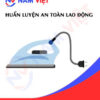Occupational Safety Training in Lock Manufacturing
99,000 ₫
Note: The above price is calculated for one person, and the price may fluctuate depending on the number of trainees participating in the course and market movements. For more accurate pricing support, please refer to the quotation table or contact our consulting staff directly.
Occupational safety is an important issue in lock manufacturing factories and needs to be addressed promptly to ensure the health and safety of workers, while enhancing the reputation of businesses. The Occupational safety training course is one of the effective solutions to raise awareness of accident prevention for workers participating in lock manufacturing.
Table of Contents
Toggle1. Overview of Locks
a. What is a lock?
A lock is a mechanical device used to secure and open doors, cabinets, boxes, suitcases, or any item that can be locked. It consists of a locking mechanism and one or more keys to operate it. When the keys are inserted into the lock and turned, the components inside the lock move to either lock or unlock it.
Types of locks include padlocks, combination locks, electronic locks, and other specialized locks. Locks can be used in various settings, from residential homes to industrial facilities.

b. Machinery used in lock manufacturing
The main machines involved in lock manufacturing include:
- Wire cutting machine: This machine is used to cut steel wires into specific lengths for making lock components.
- Plastic injection molding machine: Used to mold plastic into various shapes and sizes to form lock parts.
- CNC lathe machine: Used to machine mechanical parts of the lock, ensuring precision and durability.
- Grinding machine: Used to polish and refine lock components for accuracy and smoothness.
- Heat treatment machine: Used to heat-treat lock components to ensure hardness and durability.
- Welding machine: Used to weld lock parts together to create a complete product.

c. Lock manufacturing companies in Vietnam
In Vietnam, there are many companies producing locks. Some notable ones include:
- KCC Locks – One of the leading lock manufacturers in Vietnam, established in 1995.
- Vina Lock – A company with extensive experience in lock manufacturing in Vietnam, established in 1994.
- Duy Tân Lock – Based in Hanoi, specializing in producing and supplying locks for domestic and international markets.
- Khoa Việt – A company specializing in manufacturing lock-related products, including door locks and cabinet locks.
- Bình Minh Lock – A reputable Vietnamese lock manufacturer known for high-quality products.

d. Specific roles in a lock manufacturing factory
Group 1
- Executive director, deputy director, and department heads in the lock manufacturing factory.
Group 2
- Safety officers: manage safety in the factory, design safety procedures, monitor, and ensure staff compliance with safe work practices.
Group 3
- Fabrication and machining of components: Lock components are made from materials such as steel, copper, aluminum, etc., then machined using CNC equipment to create parts like handles, lock mechanisms, rotating shafts, etc.
- Assembly: Lock components are assembled and thoroughly checked to ensure accuracy and safety for users.
- Quality control: Each lock is quality-checked before packaging to ensure proper functionality and compliance with company standards.
- Packaging and transportation: Finished products are packaged and transported to warehouses or partners for market distribution.
Group 4
- Office tasks, services, sales, marketing.
- manufacturing management, quality management, human resources management, materials management, financial accounting management.
- Product design and development: The design team creates technical drawings for each type of lock based on customer requirements or company manufacturing factories.

2. Overview of Occupational Safety Training for Lock Manufacturing
This article focuses on issues related to Group 3, as Group 3 directly participates in manufacturing and faces the highest occupational safety risks. For other groups, see here.
a. What is Group 3 occupational safety training?
- Group 3 occupational safety training consists of sessions that equip workers with awareness on preventing workplace accidents.
- The training helps workers recognize hazards and prevent risks, reducing the likelihood of accidents during work.
REGISTER FOR OCCUPATIONAL SAFETY TRAINING SERVICE
b. Training duration
Initial safety training duration
- Total training duration is at least 24 hours, including assessment time.
- 8 hours of theoretical study on policies, laws, and occupational safety regulations
- 8 hours of basic knowledge about occupational safety and hygiene
- 4 hours of theoretical training on specialized content
- 2 hours of practical training on specialized content
- 2 hours of final theoretical exam
The safety training center may split the schedule into multiple sessions depending on the employees’ availability. Typically, there are 6 training sessions conducted over 3 days, provided the company can arrange continuous learning time.
Periodic safety training duration
- Before the occupational safety card expires, employees who wish to renew must undergo periodic occupational safety training, with the periodic training duration being at least 50% of the initial training duration.
Explanation: The total periodic occupational safety training duration is at least 12 hours, including assessment time. After completing the periodic training and passing the test, employees will have their occupational safety cards renewed.
c. Training content
| No. | TRAINING CONTENT | TRAINING DURATION (HOURS) | |||
| Total | Including | ||||
| Theory | Practice | Assessment | |||
| I | System of policies and laws on occupational safety and hygiene | 8 | 8 | 0 | 0 |
| 1 | Overview of legal documents on occupational safety and hygiene. | 6 | 6 | ||
| 2 | Standards and technical regulations on occupational safety and hygiene. | 1 | 1 | ||
| 3 | Specific regulations from state management agencies on occupational safety and hygiene when building, expanding, or renovating facilities, producing, using, storing, or inspecting machines, equipment, materials, or substances requiring strict safety standards. | 1 | 1 | ||
| II | Basic knowledge of occupational safety and hygiene | 8 | 8 | 0 | 0 |
| 1 | Basic knowledge of hazards and harmful factors in the workplace. | 4 | 4 | ||
| 2 | Methods to improve working conditions. | 1 | 1 | ||
| 3 | Safety culture in manufacturing and business. | 1 | 1 | ||
| 4 | Rights and responsibilities of employers and employees; occupational safety policies and regulations for employees; roles and duties of safety officers. | 1 | 1 | ||
| 5 | Occupational safety rules, signs, guidance boards, use of safety equipment and personal protective equipment; first aid skills and prevention of occupational diseases. | 1 | 1 | ||
| III | Specialized training content | 6 | 4 | 2 | 0 |
| Comprehensive knowledge of machines, equipment, substances generating hazardous factors; risk analysis, assessment, and management in occupational safety; safe working procedures with machines, equipment, and substances requiring strict safety standards. | 6 | 4 | 2 | ||
| IV | Final assessment of occupational safety training | 2 | 2 | 0 | 0 |
| Total | 24 | 22 | 2 | ||
See also training content of all 6 groups
d. Occupational safety card
After completing occupational safety training and passing the assessment, employees will be issued an occupational safety card (commonly referred to as a Group 3 safety certificate).
The Group 3 safety card includes information such as full name, date of birth, job, and specific work environment. It also shows training duration, a red stamp, and a signature confirming course completion.
According to the regulations on issuing safety cards in Clause 2 of Article 24, Decree 44/2016/ND-CP, there are two cases:
- If the employer and employee have a labor contract, the employer must sign, stamp, and affix a seal on the safety card for the Group 3 employee after completing training from the occupational safety training unit and passing the assessment.
- If the worker is freelance, temporary, or does not have a labor contract, the training unit must sign, stamp, and affix a seal on the safety card after the worker completes training and passes the assessment.

3. Identifying hazards affecting workers during lock manufacturing
Some potential hazards during lock manufacturing include:
- Fire and explosion risk: Due to the use of chemicals and flammable materials, along with the use of air compressors, cutting machines, chisels, drills, grinding machines… sparks and high temperatures may be generated, causing fire or explosions.
- Risk of entrapment: Machinery in lock manufacturing plants may pose a risk of getting trapped or caught while operating, especially when safety procedures and instructions are not followed.
- Risk of punctures and cuts: During manufacturing, workers may come into contact with sharp tools such as knives, scissors, and other cutting parts, which can cause injuries, cuts, punctures, or serious harm.
- Risk of chemical exposure: The use of chemicals such as dyes, solvents, adhesives… may pose dangers to workers if safety regulations are not followed and proper usage is not ensured.
- Risk of respiratory obstruction: Lock manufacturing may generate dust and fumes from machining, assembly, welding… Without proper dust extraction and ventilation, this can obstruct workers’ respiratory systems.
- Risk of collision and falls: Operating machinery, moving heavy materials and equipment may pose a risk of collision or falls if safety procedures are not followed.
- Electrical hazards: If electrical equipment in the factory is not regularly maintained, properly insulated, or waterproofed, it may pose a risk of electric shock to workers during manufacturing.
4. Common occupational accidents for workers during lock manufacturing
Common occupational accidents in lock manufacturing may include:
- Hand cutting accidents: Machinery and tools during lock manufacturing may cause hand cutting injuries if safety rules are not followed and protective equipment is not used.
- Collision injuries: Workers may be injured due to collisions with heavy objects or moving materials during lock manufacturing and transportation.
- Chemical poisoning: Lock manufacturing may involve exposure to hazardous chemicals, leading to poisoning if workers do not use proper protective and safety measures.
- Electrical accidents: Machinery in lock manufacturing often uses high voltage and may pose danger if electrical safety rules are not followed.
- Accidents from working in noisy environments: Machinery in lock factories often generates high noise levels, potentially harming workers’ hearing if ear protection and sound filtering are not used.

5. Safety measures when participating in lock manufacturing
Safety measures for participating in lock manufacturing include:
- Use of protective equipment: Workers need to use protective equipment such as helmets, safety goggles, gloves, coats, safety shoes to minimize risks during manufacturing.
- Occupational safety training: Manufacturing staff must be trained on safety procedures, occupational safety regulations, and the proper use of protective equipment.
- Equipment control and maintenance: Machinery and equipment in lock factories should be regularly checked and maintained to ensure safe and efficient operation.
- Ensure workplace hygiene: Maintain cleanliness and ventilation in lock manufacturing factories to minimize risks to workers.
- Product quality inspection: Locks must be checked for quality before use to ensure safety and technical compliance.
- Follow manufacturing procedures correctly: Manufacturing staff must follow proper procedures, not violate safety regulations, and not use equipment improperly or without proper authorization.
- Waste management: Implement proper waste management procedures to avoid harm to the environment and human health.
- Periodically conduct occupational environment monitoring in factories, collecting and analyzing harmful factors to adjust and reduce hazards, thereby preventing occupational diseases.
6. Benefits of occupational safety training for lock manufacturing
An Toan Nam Viet provides businesses with excellent benefits after completing occupational safety training courses in accordance with Decree 44/2016/ND – CP regarding Occupational Safety and Hygiene for companies, factories, and enterprises.
- Workers can identify potential occupational hazards and take preventive measures to avoid accidents.
- Businesses can establish risk prevention measures in manufacturing, operation, and maintenance processes.
- Reduce costs associated with safety risks at work.
- Uninterrupted manufacturing increases labor productivity and product quality.
- Compliance with labor safety laws, avoiding legal risks.
- Build credibility and professionalism, thereby enhancing the brand of your enterprise.
Nam Viet’s training courses are solutions to prevent and counter external factors that may cause harm, injury, or even death.
REGISTER FOR OCCUPATIONAL SAFETY TRAINING SERVICE
7. Customer feedback after completing occupational safety training for lock manufacturing
An Toan Nam Viet has many years of experience in accompanying businesses across Vietnam in general and southern provinces in particular. This responsibility is extremely valuable to Nam Viet, which is why our Occupational Safety Training is increasingly professional. The motivation for An Toan Nam Viet’s growth comes from positive feedback and suggestions from enterprises. Below are the testimonials of our partners.
Bac Nam E&C Construction Investment Joint Stock Company
“My first experience with An Toan Nam Viet was very surprising due to the 24/7 enthusiastic support from the consulting team. The class organization was quick and convenient for our company, many thanks to Nam Viet’s service!”
Hoa Dat Construction and Trading Joint Stock Company
“Nam Viet’s service greatly simplified occupational safety and helped complete safety documentation for our work process. The consulting team is enthusiastic and timely in addressing our inquiries. 5 stars for Nam Viet.”
See more customer interview sessions after using the service of An Toan Nam Viet
8. Occupational Safety Training Capacity of An Toan Nam Viet
An Toan Nam Viet is a reputable and high-quality occupational safety training center in Vietnam, conducting continuous training sessions at manufacturing workshops, factories, or construction sites nationwide (all 63 provinces in Vietnam).
REGISTER FOR OCCUPATIONAL SAFETY TRAINING SERVICE
Occupational Safety Training License
- An Toan Nam Viet has been inspected and certified by the Department of Safety under Ministry of Labor – Invalids and Social Affairs, certifying our eligibility to conduct occupational safety and hygiene training. This further strengthens our occupational safety training capabilities.

Materials and Lessons
- Before being used in occupational safety training courses, materials are reviewed and approved to ensure knowledge accuracy and effective application.
- Teaching methods of instructors are standardized according to An Toan Nam Viet standards, researched and compiled by occupational safety experts to maximize learning efficiency for trainees.
Facilities
- Controlling classroom factors affecting training increases teaching efficiency and knowledge absorption.
- Our training facilities always provide spacious classrooms meeting standards in area, lighting, training equipment, etc.
9. Nationwide reputable occupational safety training center
At An Toan Nam Viet, we prioritize occupational safety training. Educating workers on self-protection equips them with safety knowledge for their livelihood and contributes to national development.
To ensure effective training, we meticulously prepare every detail, from tools and teaching equipment to curriculum, materials, sound, and lighting.
Our occupational safety instructors are experts with many years of experience, including research on hazard identification in various professions and prevention methods.
Lessons are practical and delivered vividly for easy understanding. This ensures trainees are comfortable and absorb knowledge effectively, always aligned with Decree 44/2016/ND-CP.
Thus, workers learn hazard prevention measures and self-protection, applying them effectively in real work situations.
Our training center proudly provides professional occupational safety training with the following advantages:
- Competitive training fees while ensuring quality.
- Flexible training schedules to suit company manufacturing.
- Quick and legally compliant certification procedures.
- Experienced instructors with many years in the field.
- Classroom conditions controlled to maximize teaching efficiency and knowledge retention.
- Lessons tailored to occupational safety at enterprises.
- Dedicated, professional service providing accurate and timely support to clients.

10. Additional references for occupational safety training in lock manufacturing
- Occupational safety documents for lock manufacturing
- Complete occupational safety training documents
- Occupational safety training test sets
- Occupational safety training curriculum for lock manufacturing
- Occupational safety multiple-choice test for lock manufacturing
1 review for Occupational Safety Training in Lock Manufacturing
No comments yet















namchinh.haiphong341
Dịch vụ tốt!!!